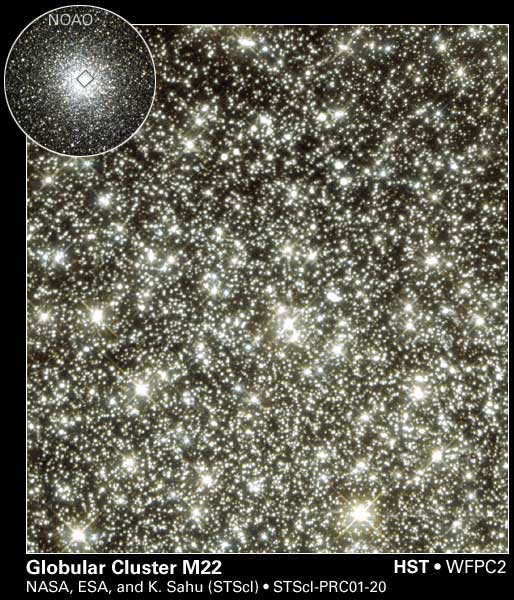

Piercing the heart of globular star cluster M22, NASA's Hubble Space Telescope uncovered clues to what could be a strange and unexpected population of wandering, planet-sized objects. The orbiting observatory detected these bodies by the way their gravity bends the light from background stars, a phenomenon called microlensing. These microlensing events were unusually brief, indicating that the mass of the intervening objects could be as little as 80 times that of Earth. Bodies this small have never previously been detected by microlensing observations.
The telescope's view of the cluster's core measures about 3.3 light-years across. The stars near the cluster's core are 100,000 times more numerous than those in the Sun's neighborhood.
From February 22 to June 15, 1999, Hubble's Wide Field and Planetary Camera 2 looked through this central region and monitored 83,000 stars. During that time the orbiting observatory recorded six unexpectedly brief microlensing events. In each case a background star jumped in brightness for less than 20 hours before dropping back to normal. These transitory spikes in brightness mean that the object passing in front of the star must have been much smaller than a normal star. It is estimated that these objects may have a mass of 80 times that of Earth, less than Saturn (which has 96) and about 1/4 that of Jupiter.
Hubble also detected one clear microlensing event. In that observation a star appeared about 10 times brighter over an 18-day span before returning to normal. It is thought that this leap in brightness was caused by a dwarf star in the cluster floating in front of the background star.
The insert photo was obtained at Kitt Peak National Observatory.
![[SEDS]](../../Jco/seds1.jpg)
![[MAA]](../../Jco/maa.jpg)
![[Home]](../../Jco/messier.jpg)
![[Back to M22]](../../Jcon/m22.ico.jpg)
![[HST: M Objects]](../../Jco/hubble.ico.jpg)
Last Modification: August 17, 2001